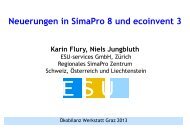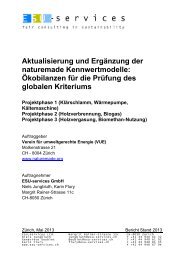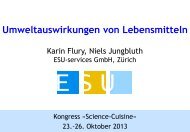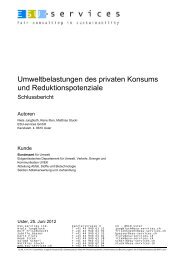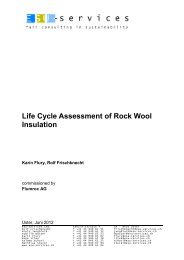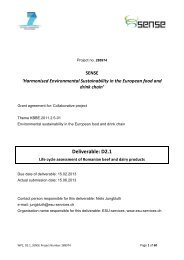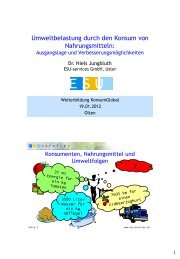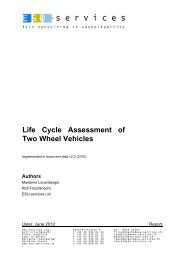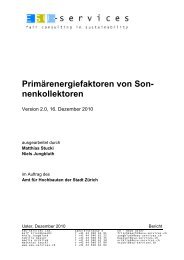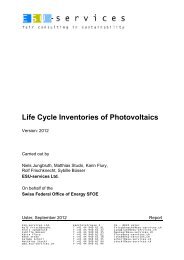Life-Cycle-Assessment for Stoves and Ovens - ESU-services Ltd.
Life-Cycle-Assessment for Stoves and Ovens - ESU-services Ltd.
Life-Cycle-Assessment for Stoves and Ovens - ESU-services Ltd.
You also want an ePaper? Increase the reach of your titles
YUMPU automatically turns print PDFs into web optimized ePapers that Google loves.
4 Interpretation<br />
The life-cycle-impact-assessment gives interesting insights in environmental impacts caused<br />
by various cooking options. A first result is the large gap between the results <strong>for</strong> electric<br />
cooking in Western-Germany <strong>and</strong> Switzerl<strong>and</strong> due to the differences in the electricity production.<br />
Power generation in Switzerl<strong>and</strong> is mainly based on nuclear fuels <strong>and</strong> hydro-power<br />
whereas in Germany fossil fuels have the highest share. The comparison between gas (CH)<br />
<strong>and</strong> electricity (D) shows a clear preference <strong>for</strong> the first.<br />
There is not such a clear outcome if the alternatives are compared <strong>for</strong> the situation in Switzerl<strong>and</strong>.<br />
A comparison based only on the method of Eco-indicator 95+ does not provide satisfying<br />
results because the impacts of electricity production in Switzerl<strong>and</strong> in some categories,<br />
e.g. radioactive releases <strong>and</strong> l<strong>and</strong> use are not valued. From a valuation using the additional<br />
impact categories radioactivity, space use, waste heat (as an indicator <strong>for</strong> the use of energy resources)<br />
<strong>and</strong> eoctoxicity, cooking with natural gas is better considering radioactive releases<br />
<strong>and</strong> space use. With regard to terrestrial ecotoxicity <strong>and</strong> waste heat the impacts caused by a<br />
gas stove are higher than those of using electricity. In other categories the impacts of gas use<br />
are about the same.<br />
Considering the uncertainty of data (e.g. efficiencies of different stoves) <strong>and</strong> methods (impact<br />
assessment <strong>for</strong> indoor pollution) the differences of the two possibilities do not lead to a clear<br />
ranking. The overall environmental impacts of cooking with gas or electricity in Switzerl<strong>and</strong><br />
are assessed here to be about the same.<br />
The impacts of cooking with wood depend mainly on the question whether or not the waste<br />
heat of the stove is used <strong>for</strong> room heating. Thus the stove achieves a high overall efficiency.<br />
Cooking with wood is an ecological alternative to the other options if the heat of the fire can<br />
be used <strong>for</strong> room heating. Cooking on a 3-stone fire shows to have relative high environmental<br />
impacts. Especially the toxic effects 28 to human being should be considered while<br />
valuing this option.<br />
Cooking with LPG might be a theoretical alternative to the other types of energy. But from an<br />
environmental point of view there is no clear constraint <strong>for</strong> it. The use of kerosene <strong>for</strong> cooking<br />
is also not environmentally friendly in comparison to the other alternatives.<br />
It should be taken into account, that the environmental impacts depend considerably on the<br />
efficiency of the stove used <strong>and</strong> on the energy consumed due to the users' behavior. Thus <strong>for</strong><br />
all types of stoves further developments towards a higher efficiency <strong>and</strong> proper roles <strong>for</strong> the<br />
consumers' behavior are desirable to minimize the environmental impacts of cooking.<br />
To compare the cooking alternatives more reliable, further methodological improvements are<br />
necessary <strong>for</strong> the inclusion of l<strong>and</strong> use <strong>and</strong> radioactive releases in the method Eco-indicator<br />
95. Further on a separated valuation of indoor air quality effects is necessary to assess the<br />
health effects of pollutants released during cooking in more detail.<br />
The data investigated in this report are satisfying in regard to the inclusion of the environmental<br />
impacts of cooking in further LCA studies. But to compare different cooking alternatives<br />
in detail more in<strong>for</strong>mation is necessary regarding the efficiency of stoves <strong>and</strong> a good<br />
method to compare it. An other data gap are the measurements of emissions available <strong>for</strong> the<br />
28<br />
The figure <strong>for</strong> the environmental effect human toxicity (8940 kg) is about three times higher than this <strong>for</strong> the<br />
second worst option electric stove in Germany.<br />
- 24 -



